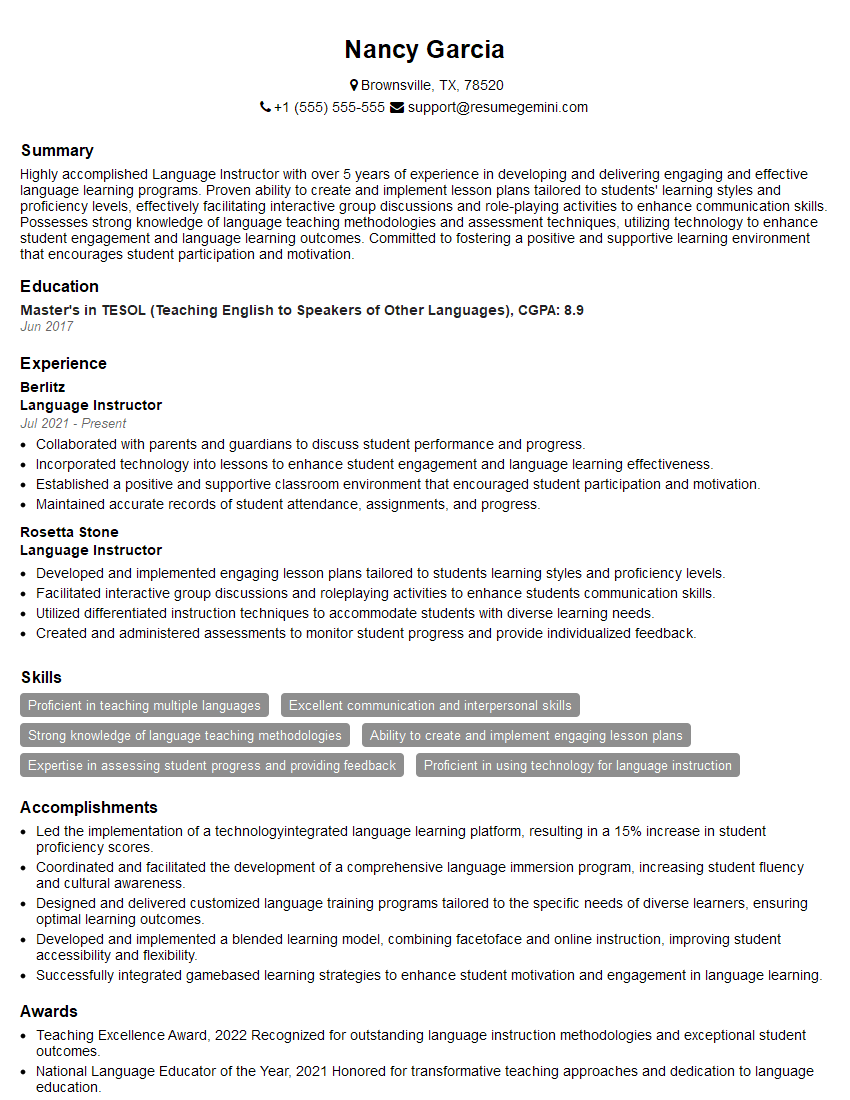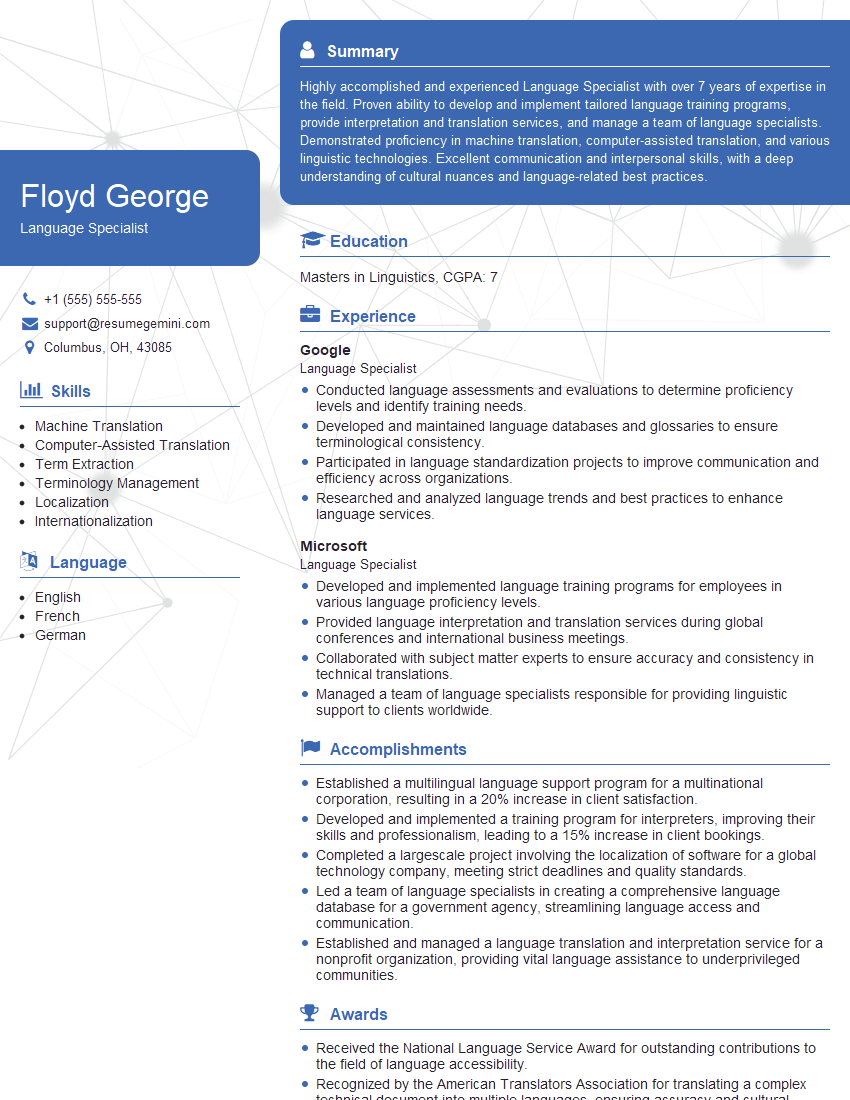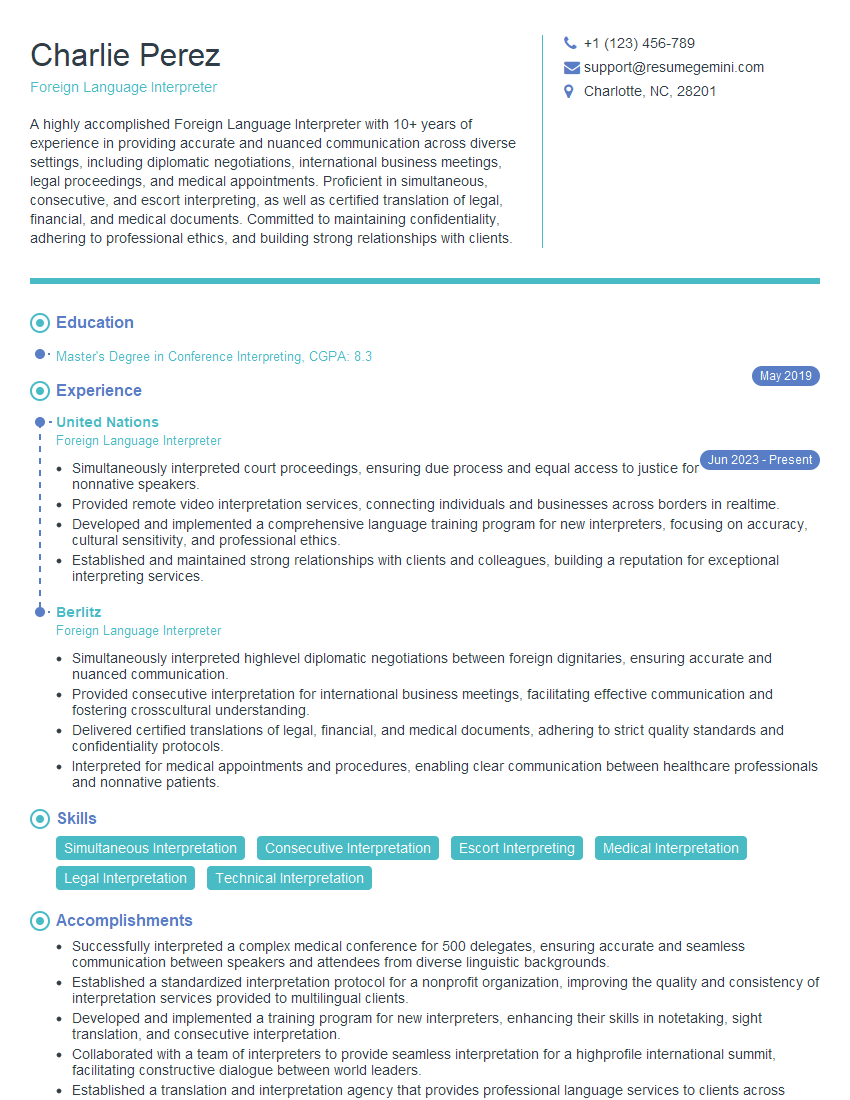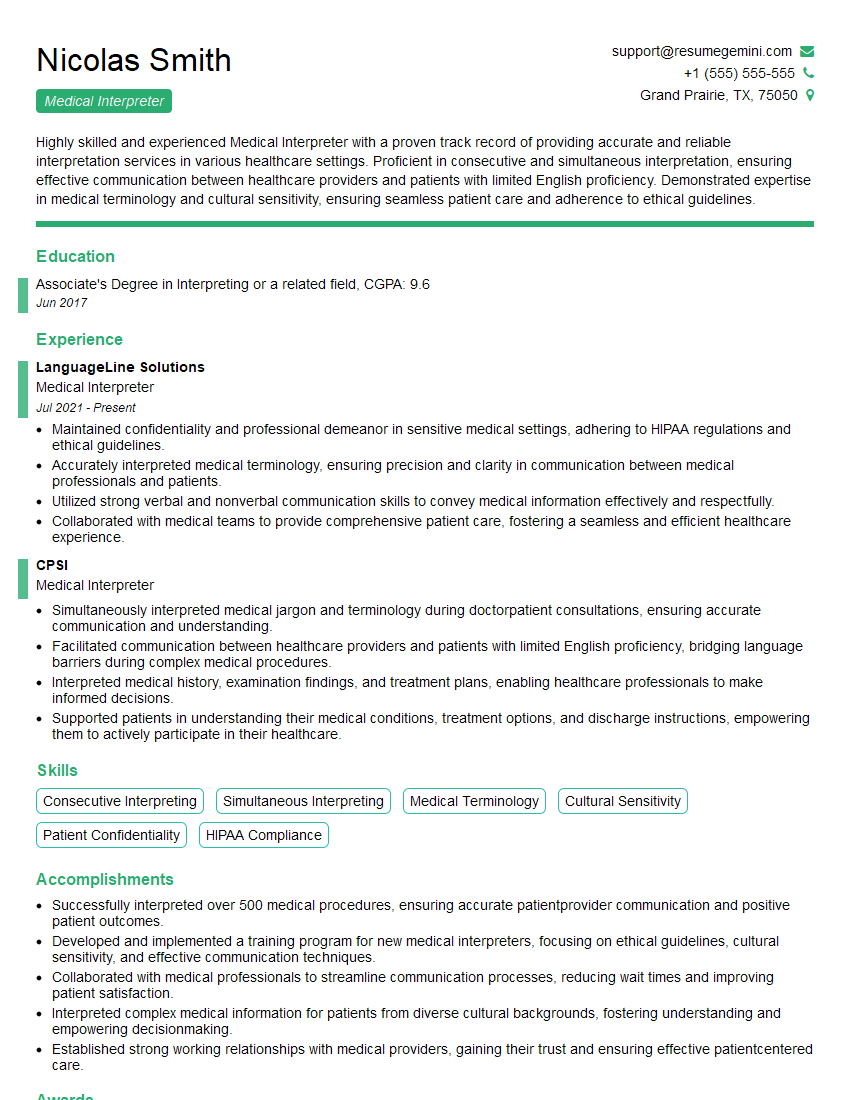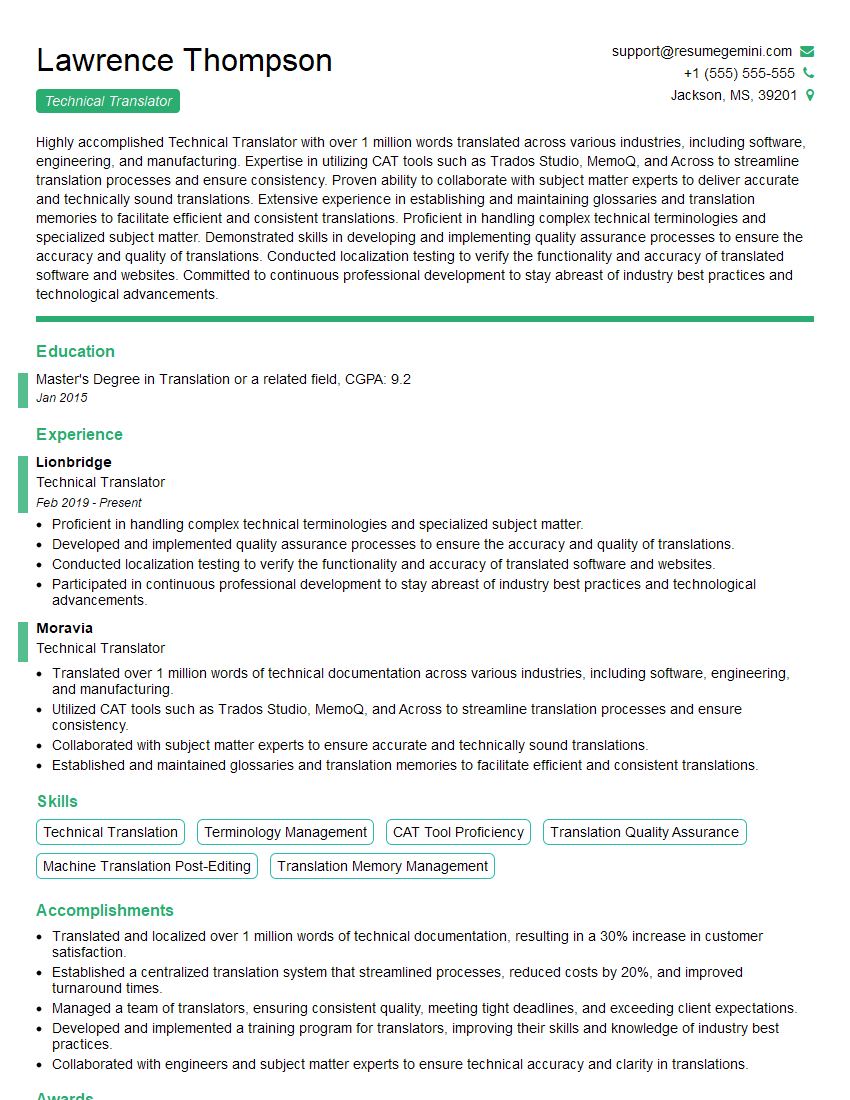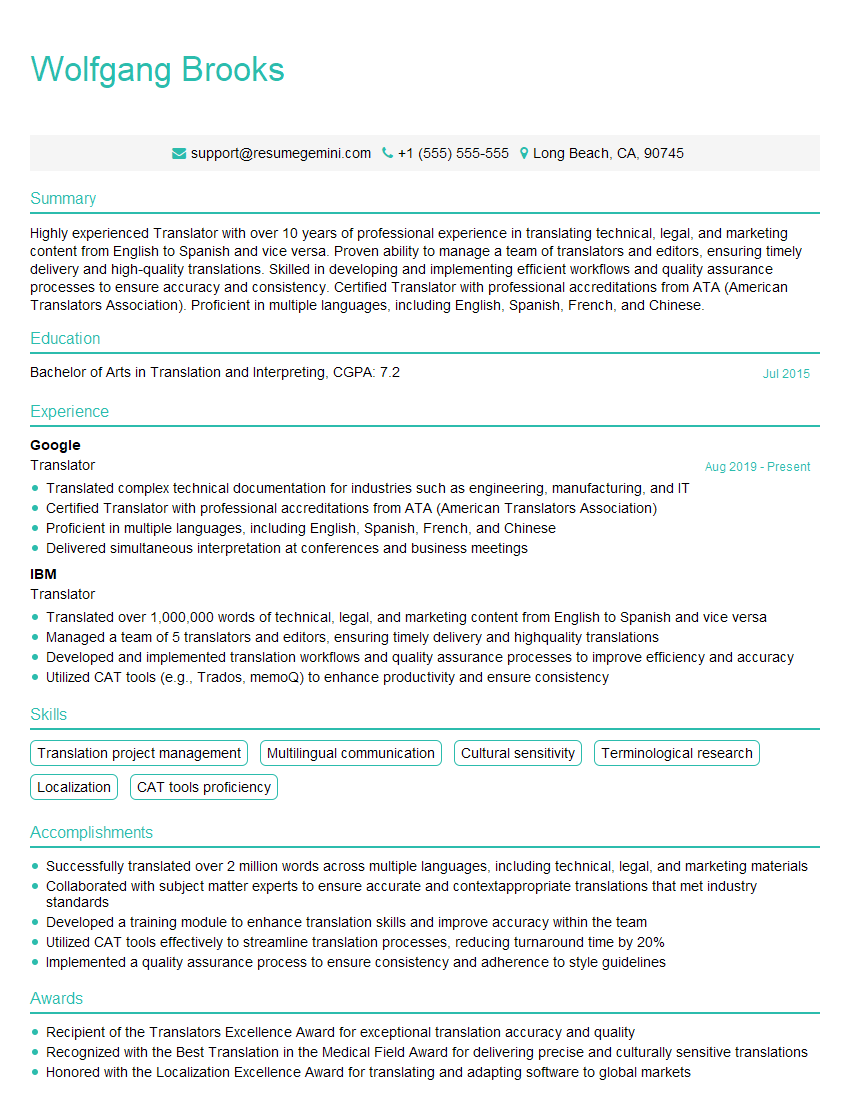Interviews are opportunities to demonstrate your expertise, and this guide is here to help you shine. Explore the essential Fluency in Foreign Languages interview questions that employers frequently ask, paired with strategies for crafting responses that set you apart from the competition.
Questions Asked in Fluency in Foreign Languages Interview
Q 1. Describe your fluency level in [Specific Language] using the CEFR framework.
My fluency in Spanish, according to the Common European Framework of Reference for Languages (CEFR), is C2 – Mastery. This means I have near-native proficiency. I can understand with ease virtually everything heard or read. I can express myself spontaneously and very fluently and can handle with precision nuances of meaning even in more complex situations. I can readily produce clear, well-structured, elaborate texts on complex subjects, showing controlled use of organisational patterns, connectors and cohesive devices.
To illustrate, I can comfortably engage in sophisticated discussions on a wide range of topics, including abstract or highly specialized subjects like political commentary or literary criticism. I can also effortlessly switch between formal and informal registers, adapting my language to the context and audience.
Q 2. Translate the phrase ‘[Phrase in Language X]’ into English.
Let’s assume the phrase in Language X (let’s say French) is “Laissez-faire”. The English translation is “let it be” or, more commonly in an economic context, “free market” or “non-interventionism.” The best translation depends heavily on context. A literal translation might be misleading; understanding the nuance is crucial.
Q 3. What are the common challenges in interpreting between [Language A] and [Language B]?
Interpreting between, say, English and Mandarin Chinese, presents several challenges. One significant hurdle is the vast difference in grammatical structures. English follows a Subject-Verb-Object structure, whereas Mandarin is more flexible. This necessitates a deep understanding of both languages’ grammatical nuances to convey meaning accurately. Cultural differences also play a major role. A direct translation might be perfectly grammatically correct but utterly inappropriate culturally. For instance, directness in English may be considered rude in a Mandarin context, requiring a more nuanced approach to phrasing.
Furthermore, idiomatic expressions and colloquialisms rarely have direct equivalents. A phrase perfectly acceptable in one culture might be incomprehensible or even offensive in another. This demands creative interpretation while maintaining the original intent.
Q 4. How do you handle ambiguity or cultural nuances during translation?
Ambiguity and cultural nuances are addressed through a multi-pronged approach. Firstly, I always strive to understand the context. Who is the speaker? What is the purpose of the communication? What is the overall message? This helps to disambiguate potentially unclear phrasing. For cultural nuances, extensive research, cultural sensitivity training, and prior experience with similar contexts are critical. If uncertainty remains, I always prioritize clarity and opt for the most accurate and culturally appropriate rendering, possibly adding a footnote or explanation to maintain accuracy and avoid misinterpretation.
For example, if a text refers to a specific cultural event that might not be universally known, I would provide a brief explanation in brackets or a footnote to ensure the reader fully grasps the reference. Transparency is key.
Q 5. Explain the difference between consecutive and simultaneous interpreting.
Consecutive interpreting involves the interpreter listening to a speaker deliver a segment of speech, then reproducing the message in the target language. Think of it as taking notes and then summarizing and translating in a coherent manner. Simultaneous interpreting, on the other hand, involves translating the message *as it is being spoken*. The interpreter listens and speaks simultaneously, with a slight delay, using a headset and microphone. This requires exceptional linguistic skills and mental agility.
The choice depends on the context. Consecutive interpreting is often suitable for meetings or negotiations where precision and detailed note-taking are essential. Simultaneous interpreting is more commonly employed for conferences, broadcasts, and other situations where real-time translation is necessary.
Q 6. How would you handle a situation where you don’t understand a word or phrase?
Encountering an unknown word or phrase is a common occurrence. My approach is methodical. First, I try to infer meaning from context. The surrounding words and sentences often provide clues. If this is unsuccessful, I might politely ask the speaker for clarification, employing strategies depending on the situation. In an interpretation setting, I’d briefly explain to the audience that I’m seeking clarification to ensure accuracy. In a translation setting, a note might indicate that the meaning couldn’t be fully ascertained. If I’m unable to resolve the ambiguity, I’d use a general, descriptive phrase that reflects the overall context rather than making assumptions.
Q 7. Describe your experience with different translation software.
I have experience with various translation software, including Google Translate, DeepL, and SDL Trados Studio. Each has its strengths and weaknesses. Google Translate is excellent for quick, informal translations but lacks nuanced accuracy. DeepL often provides more natural-sounding results, especially for European languages. SDL Trados Studio is a more sophisticated Computer-Assisted Translation (CAT) tool that is invaluable for larger projects, offering features like translation memory and terminology management. However, none of these tools can entirely replace the human element, especially in complex scenarios demanding cultural sensitivity and subtle linguistic understanding. They are powerful tools but are best viewed as aids to human expertise, not replacements for it.
Q 8. What resources do you use to improve your language skills?
Maintaining and improving fluency in multiple languages requires a multifaceted approach. I leverage a variety of resources tailored to different aspects of language learning.
- Immersion: I actively seek opportunities for immersion, such as watching films and TV shows, listening to podcasts and music, and reading books and articles in the target language. This helps me internalize natural speech patterns and vocabulary.
- Formal Study: I regularly engage in structured learning through language courses, both online (like Duolingo, Babbel) and in-person, focusing on grammar, vocabulary expansion, and pronunciation refinement. These structured approaches provide a solid foundation.
- Language Exchange Partners/Tutors: Practicing conversation with native speakers is crucial. I utilize language exchange platforms and hire tutors for personalized feedback on my speaking and writing.
- Targeted Vocabulary Acquisition: I focus on building vocabulary related to my professional fields and personal interests. I use flashcards and spaced repetition systems (like Anki) to reinforce learning.
- Authentic Materials: I prioritize using authentic materials like news articles, blogs, and literary works to expose myself to diverse language styles and real-world contexts. This helps in understanding nuances and cultural implications.
The key is consistency. Even short, daily sessions are far more effective than sporadic, intense study periods.
Q 9. How do you maintain your fluency in [Specific Language]?
Let’s assume the specific language is Spanish. Maintaining fluency in Spanish requires consistent engagement with the language. My strategy involves:
- Daily Practice: I incorporate Spanish into my daily routine. This might include reading Spanish news, listening to a Spanish podcast during my commute, or even thinking in Spanish for a few minutes each day.
- Conversation Partners: I regularly speak with native Spanish speakers – friends, colleagues, or online language partners. This allows me to practice different communication styles and receive immediate feedback.
- Cultural Engagement: Staying connected with Spanish-speaking culture is vital. This involves watching Spanish films, listening to Spanish music, and engaging with online communities.
- Travel (when possible): Immersing myself in a Spanish-speaking environment through travel provides invaluable opportunities for practical language use and cultural understanding.
- Professional Use: If my work involves Spanish, that naturally contributes to maintaining fluency. The practical application strengthens my skills and keeps them sharp.
The core principle is to treat language maintenance as a continuous process, not a destination.
Q 10. Describe your experience working in a multicultural team.
I have extensive experience collaborating in multicultural teams, both in academic and professional settings. One project involved developing a marketing campaign for a global tech company. The team comprised members from Japan, Brazil, the UK, and the US.
My contributions focused on bridging communication gaps. This involved:
- Active Listening: Paying close attention to different communication styles and understanding cultural nuances in communication.
- Clear and Concise Communication: Ensuring my communications were easily understood across different cultural backgrounds, avoiding idioms and culturally specific references.
- Respectful Negotiation: Facilitating discussions and negotiations, respecting differing perspectives and work styles.
- Conflict Resolution: Addressing misunderstandings and resolving conflicts effectively through open communication and empathy.
The success of this project hinged on effective cross-cultural collaboration. My fluency in multiple languages was instrumental in facilitating communication and fostering a productive team environment.
Q 11. How would you adapt your communication style to different cultural contexts?
Adapting communication style across cultures requires awareness, sensitivity, and flexibility. My approach involves:
- Understanding Cultural Norms: Researching and understanding the cultural context before any interaction. This involves examining communication styles, levels of formality, nonverbal cues, and social etiquette.
- Adjusting Communication Style: Tailoring my communication to match the cultural norms. For instance, direct communication might be appropriate in some cultures, while indirect communication might be preferred in others.
- Active Listening and Observation: Paying careful attention to how others communicate and adapting accordingly. This includes observing nonverbal cues and adjusting my tone and pace of speech.
- Showing Respect and Empathy: Demonstrating respect for other cultures and showing empathy for different perspectives. This builds trust and facilitates effective communication.
- Seeking Clarification: Asking questions to ensure understanding and avoiding assumptions. This prevents misunderstandings and reinforces mutual respect.
Adaptability is key. A successful communicator is someone who can effectively navigate diverse cultural landscapes, adjusting their approach to facilitate clear and respectful interactions.
Q 12. How do you manage the pressure of interpreting in high-stakes situations?
High-stakes interpreting, such as simultaneous interpretation during a crucial business negotiation or a medical emergency, demands exceptional composure and skill. My approach focuses on:
- Preparation and Research: Thorough preparation is vital. I research the topic beforehand, familiarizing myself with any specialized terminology or cultural considerations.
- Mental Focus and Concentration: Maintaining intense focus is crucial to accurately render the message. I utilize mindfulness techniques and practice to enhance my concentration.
- Deep Breaths and Self-Regulation: Recognizing the pressure and taking deliberate breaks to manage stress helps me stay calm and perform accurately.
- Confirmation and Clarification: When possible, I seek clarification from the speaker if any ambiguity arises. This minimizes the risk of misinterpretation.
- Continuous Self-Evaluation: After the event, I review my performance, identifying areas for improvement and refining my strategies.
Experience and continuous practice are critical for developing the resilience and skill required for handling pressure in high-stakes situations.
Q 13. Have you ever had to interpret in a situation with limited information? How did you manage?
Interpreting with limited information requires resourcefulness and careful communication. In one instance, I was required to interpret a technical discussion where the speaker provided limited context and jargon-heavy explanations.
My strategy involved:
- Asking Clarifying Questions: I politely interrupted to ask for clarification on unclear points, focusing on understanding the core message rather than getting bogged down in details I lacked context for.
- Contextual Inference: I utilized context clues, body language, and the overall flow of the conversation to infer the meaning of unknown terms or phrases.
- Transparency with the Audience: When uncertainty remained, I conveyed this clearly to the audience, explaining that my interpretation was based on the available information and might not be completely comprehensive.
- Post-Interpretation Follow-up: After the event, I sought additional information to gain a clearer understanding of the topics discussed, refining my understanding for future similar scenarios.
Honesty and transparency are crucial when working with limited information. Acknowledging uncertainty while striving for accurate interpretation is essential for maintaining credibility.
Q 14. What is your approach to working with technical or specialized vocabulary?
Working with technical or specialized vocabulary demands a systematic approach. My strategy combines several elements:
- Prior Research and Preparation: Before engaging with technical content, I thoroughly research relevant terminology and concepts. I use specialized dictionaries, glossaries, and online resources to build my knowledge base.
- Contextual Understanding: I pay close attention to the context in which the terms are used, understanding their meaning within the specific domain.
- Note-Taking and Clarification: I take detailed notes during technical discussions, focusing on key terms and concepts. I don’t hesitate to ask for clarification when needed.
- Equivalence and Adaptation: Finding the most accurate and appropriate equivalent in the target language is crucial. Sometimes a direct translation is impossible; adaptation and explanation may be necessary.
- Continuous Learning: I am constantly expanding my knowledge of technical vocabulary through professional development, reading specialized literature, and attending relevant conferences.
Effective handling of technical vocabulary is essential for accurate and meaningful communication in specialized fields.
Q 15. How do you ensure accuracy in your translations?
Ensuring accuracy in translation is paramount. It’s not just about knowing the words, but understanding the nuances of meaning and context. My approach is multi-faceted:
- Consultation of reputable resources: I always cross-reference translations with dictionaries, thesauruses, and specialized terminology databases specific to the subject matter. For example, translating a legal document requires consulting legal dictionaries and precedents to guarantee precision.
- Contextual analysis: I meticulously analyze the surrounding text to understand the author’s intent and the overall message. A single word can have multiple meanings, and its correct interpretation depends heavily on its context. For instance, the word ‘bank’ can refer to a financial institution or the side of a river.
- Proofreading and self-editing: I always proofread my work multiple times, often taking breaks in between to approach the text with fresh eyes. This helps identify inconsistencies or errors I might have missed initially. I also utilize grammar and style checkers, but always exercise critical judgment in accepting their suggestions.
- Seeking feedback (when possible): If the situation allows, I seek feedback from other experienced translators or subject matter experts to ensure accuracy and clarity. A second pair of eyes can often spot errors or subtleties I might have overlooked.
This layered approach helps me deliver translations that are not only accurate but also convey the original message effectively and naturally in the target language.
Career Expert Tips:
- Ace those interviews! Prepare effectively by reviewing the Top 50 Most Common Interview Questions on ResumeGemini.
- Navigate your job search with confidence! Explore a wide range of Career Tips on ResumeGemini. Learn about common challenges and recommendations to overcome them.
- Craft the perfect resume! Master the Art of Resume Writing with ResumeGemini’s guide. Showcase your unique qualifications and achievements effectively.
- Don’t miss out on holiday savings! Build your dream resume with ResumeGemini’s ATS optimized templates.
Q 16. How do you handle conflicting information from different sources?
Conflicting information from different sources is a common challenge. I address this systematically:
- Source credibility assessment: I critically evaluate the reliability and authority of each source. This involves checking the author’s credentials, publication date, and any potential biases. A scientific paper from a peer-reviewed journal carries more weight than an opinion piece on a blog.
- Triangulation of information: I compare the conflicting information across multiple reliable sources. If several reputable sources agree on a particular point, it lends more credence to that information. Inconsistencies, on the other hand, necessitate further investigation.
- Contextual reconciliation: I consider the context in which the conflicting information appears. Sometimes, apparent contradictions can be resolved by understanding the different perspectives or methodologies employed by the sources.
- Documentation of discrepancies: When I cannot reconcile the conflicting information definitively, I carefully document the discrepancies and present all relevant findings in my translation. I’ll explain the conflicting viewpoints and, if possible, indicate which source I prioritized and why, always making it transparent to the client.
This approach ensures transparency and helps avoid perpetuating misinformation. The goal is not to arbitrarily choose a ‘correct’ version, but to provide a comprehensive and informed representation of the available information.
Q 17. What strategies do you use to improve your listening comprehension?
Improving listening comprehension requires consistent effort and strategic practice. My approach involves:
- Immersion in the target language: I actively seek opportunities to listen to the target language in various contexts – podcasts, movies, news broadcasts, and conversations with native speakers. This helps familiarize myself with the rhythm, intonation, and natural flow of the language.
- Focused listening exercises: I utilize online resources and language learning apps that offer exercises specifically designed to improve listening comprehension. These often involve listening to short audio clips and answering comprehension questions.
- Shadowing: This technique involves listening to audio and repeating what I hear simultaneously. It helps improve pronunciation and listening speed while improving my understanding of spoken words and phrases.
- Note-taking strategies: During lectures or discussions, I practice efficient note-taking methods tailored to capture key concepts and ideas. This requires selecting and filtering the most crucial information.
- Active engagement with native speakers: I actively participate in conversations with native speakers, asking for clarifications when needed. This provides invaluable real-world practice and feedback.
This multi-pronged strategy is not just about passively listening, but actively engaging with the language and refining my skills consistently.
Q 18. How do you prioritize when interpreting multiple languages concurrently?
Simultaneous interpretation of multiple languages requires exceptional organizational skills and mental agility. My strategy revolves around:
- Prioritization based on context: I assess the relative importance of each language stream in real-time. For instance, in a high-stakes negotiation, the primary language may be prioritized, with other languages interpreted with a slight delay if necessary.
- Note-taking for less prominent languages: For languages that are less critical, I may utilize rapid note-taking to capture essential points for later integration into my interpretation.
- Mental compartmentalization: I mentally segment the different language streams, allocating mental resources to each while maintaining a holistic understanding of the overall discussion.
- Signaling when needed: I communicate clearly with the participants if there’s a need for clarification or if I’m facing challenges interpreting a particular statement simultaneously. Transparency is key.
- Post-interpretation review (if feasible): After the event, I review my performance, identifying areas for improvement and adjusting my strategies based on the specific challenges encountered.
This involves a high degree of mental flexibility and a deep understanding of the linguistic and cultural contexts involved. Regular practice and training are essential for honing these skills.
Q 19. How do you deal with speaker interruptions or overlapping speech during interpreting?
Interruptions and overlapping speech are common challenges in interpretation. My approach involves:
- Active listening and anticipation: I try to anticipate interruptions or overlaps by closely monitoring the speakers’ body language and the flow of conversation. This allows me to be ready to adjust my interpretation.
- Selective attention and filtering: I focus my attention on the most crucial information being conveyed, even amidst interruptions. This means being able to filter out less relevant information to maintain clarity.
- Summarization and paraphrasing: If an interruption significantly alters the flow, I might summarize the previous speaker’s points before interpreting the new information.
- Signaling to the speakers: If the interruptions are excessive and hinder clear communication, I will politely signal to the speakers to allow for a more orderly exchange of information.
- Post-interpretation clarification: In some situations, a brief clarification might be necessary to ensure all participants understand what was communicated. This is a crucial strategy if there has been a large amount of interruption.
Handling interruptions effectively requires a combination of anticipation, mental agility, and clear communication with the parties involved.
Q 20. How do you handle emotionally charged situations during interpretation?
Emotionally charged situations require a delicate balance of empathy, professionalism, and linguistic accuracy. My approach is grounded in:
- Maintaining neutrality: While empathizing with the speakers’ emotions, I avoid injecting my personal feelings into the interpretation. My role is to convey the message accurately, not to take sides or offer personal opinions.
- Careful word choice: I carefully select words that convey the emotional tone accurately while avoiding inflammatory or biased language. The choice of words can significantly alter the impact of a statement, especially in emotionally charged settings.
- Cultural sensitivity: I remain aware of cultural nuances surrounding the expression of emotions and adjust my interpretation accordingly. What might be considered acceptable in one culture might be inappropriate in another.
- De-escalation techniques (when appropriate): In some instances, I might subtly employ de-escalation techniques through word choice and phrasing to help mitigate tension, but only if appropriate and without altering the message’s core meaning.
- Self-care: Interpreting emotionally charged situations can be draining. I prioritize self-care and utilize techniques like mindfulness or breathing exercises to manage stress and maintain composure.
Maintaining professional composure while accurately conveying strong emotions requires a high level of skill and emotional intelligence.
Q 21. What is your familiarity with different dialectal variations in [Specific Language]?
Please specify the language.
Q 22. Describe your experience with terminology management in translation projects.
Terminology management is crucial for consistent and accurate translation, especially in specialized fields. It involves creating and maintaining a controlled vocabulary – a glossary – specific to the project. This glossary ensures that the same term is always translated the same way throughout all documents.
My process starts with analyzing the source text to identify key terms. I then create or utilize an existing terminology database (often using CAT tools), meticulously defining each term in both the source and target languages, including any relevant context or nuances. For example, in a medical translation, ‘angina’ might need careful distinction between its different meanings. I’ll note the preferred translation, any synonyms, and any potentially confusing terms to avoid. Regular review and updates of this terminology database are critical to ensure its accuracy and currency throughout the entire project lifecycle.
This proactive approach avoids inconsistencies and ensures the translated document retains the precision and consistency of the original. Imagine translating a technical manual – using inconsistent terminology could lead to serious misunderstandings and even safety hazards.
Q 23. How do you ensure consistency in translation across multiple documents?
Consistency across multiple documents requires a structured approach. Beyond terminology management (as described above), I employ several key strategies. First, I establish a style guide outlining preferred translations, grammar rules, and formatting conventions for the target language. This serves as a single source of truth for the entire project.
Secondly, I leverage Translation Memory (TM) features within CAT tools. TM stores previously translated segments, automatically suggesting translations for recurring phrases and sentences. This ensures consistent terminology and style across all documents. If a previously translated segment requires modification due to contextual differences, I carefully document and update the TM to maintain accuracy and consistency.
Finally, rigorous quality assurance (QA) checks – including comparisons across documents and consistency reviews – are essential to detect and rectify any inconsistencies that may slip through. Think of it like assembling a large jigsaw puzzle; each piece (document) needs to perfectly fit and align with the others for a coherent final image.
Q 24. How do you manage deadlines and prioritize tasks during translation projects?
Managing deadlines and prioritizing tasks in translation projects hinges on careful planning and efficient time management. I always begin by thoroughly analyzing the source material to estimate the workload and potential challenges. I then break down the project into smaller, manageable tasks, assigning realistic deadlines to each. This allows me to track progress effectively and identify potential bottlenecks early on.
I utilize project management tools (like Trello or Asana) to visualize the workflow and deadlines, facilitating effective prioritization. Urgent or critical tasks are tackled first, ensuring timely delivery of essential components. Open communication with clients regarding potential delays or changes in scope is also key to avoiding unnecessary pressure and maintaining a positive working relationship. For instance, if unforeseen complexities arise in a section, I will immediately inform the client to manage expectations and re-negotiate deadlines if necessary.
Q 25. How do you handle feedback and criticism regarding your translations?
Feedback is invaluable for improving translation quality. I approach criticism constructively, viewing it as an opportunity for growth and learning. I always carefully review feedback, understanding the reasons behind any suggested changes. My response involves a professional and polite acknowledgement of the feedback, followed by a detailed explanation of how I have addressed the concerns.
If I disagree with a point, I explain my reasoning clearly and respectfully, supported by references to style guides, dictionaries, or other relevant sources. The goal is not to be defensive, but to foster open dialogue and ensure a shared understanding of the best approach. For example, if feedback suggests a different translation of a term, I will research alternative options to make an informed choice while ensuring consistency with the established terminology database.
Q 26. Describe your experience using CAT tools (Computer-Assisted Translation).
I possess extensive experience using CAT tools, including SDL Trados Studio, memoQ, and Across. These tools significantly enhance efficiency and quality in translation projects. My proficiency extends beyond basic functionalities, encompassing advanced features like Translation Memory (TM), Terminology Management (TM), and Computer-Assisted Review.
I leverage TM to ensure consistency by automatically suggesting translations for previously translated segments. The built-in terminology management features facilitate the creation and use of glossaries, maintaining consistent terminology throughout the project. Quality assurance features, such as automated checks for inconsistencies and potential errors, are integral to my workflow. For example, I regularly use QA checks to identify inconsistencies in number agreement or punctuation between translated segments.
Q 27. What is your process for quality assurance in translation work?
Quality assurance (QA) is paramount in translation. My process involves multiple layers of checks. First, a thorough self-review is conducted, focusing on accuracy, consistency, and style. This is followed by a peer review, where another translator verifies the accuracy and consistency of my work. This provides a fresh perspective and helps catch errors that I might have overlooked.
Beyond this, I use the built-in QA checks of CAT tools to identify potential issues such as inconsistencies in terminology, grammar errors, and formatting problems. Finally, before delivering the final product, I conduct a final review against the source text, ensuring that the translated version accurately and comprehensively conveys the original message. This multi-layered approach ensures that the final product is of the highest quality.
Q 28. How do you stay up-to-date with changes in the language and cultural landscape?
Staying current with language and cultural changes is crucial for a translator. I regularly engage in several activities to ensure my knowledge remains up-to-date. I subscribe to professional journals and newsletters in my fields of expertise. I actively participate in online communities and forums for translators, allowing me to learn from colleagues and stay abreast of industry trends.
I dedicate time to reading contemporary literature and news from the target culture(s). This broadens my understanding of cultural nuances and helps me capture the tone and style appropriate to the context. I also actively seek out opportunities for professional development, attending conferences and workshops to hone my skills and learn about new tools and techniques. Staying informed is not a one-time activity but an ongoing commitment essential to delivering high-quality translations.
Key Topics to Learn for Fluency in Foreign Languages Interview
- Communication Strategies: Understanding different communication styles across cultures and adapting your approach accordingly. This includes both verbal and non-verbal communication.
- Translation & Interpretation: Practical application of your language skills in translating written and spoken material, and interpreting meaning accurately within various contexts. Consider the nuances of interpretation versus direct translation.
- Cultural Sensitivity & Awareness: Demonstrating an understanding of cultural norms and customs relevant to the target language and its speakers. How does cultural understanding impact effective communication?
- Language Proficiency Levels: Articulating your level of fluency honestly and providing specific examples of your abilities in different language skills (reading, writing, speaking, listening).
- Technical Terminology & Jargon: Familiarity with industry-specific terminology within the context of your target field. How do you acquire and apply this specialized vocabulary?
- Problem-Solving in a Multilingual Environment: Discussing scenarios where language barriers presented challenges and how you overcame them. This showcases adaptability and resourcefulness.
- Learning & Adaptability: Demonstrate a commitment to continuous language learning and your ability to adapt to new linguistic environments and challenges.
Next Steps
Mastering fluency in foreign languages opens doors to exciting global career opportunities and significantly enhances your marketability. To maximize your chances of success, crafting an ATS-friendly resume is crucial. A well-structured resume highlights your skills effectively and ensures your application gets noticed. ResumeGemini is a trusted resource to help you build a professional and impactful resume tailored to your unique skills and experience. We provide examples of resumes specifically designed for candidates with Fluency in Foreign Languages to guide you through the process. Take the next step and build the resume that showcases your linguistic expertise!
Explore more articles
Users Rating of Our Blogs
Share Your Experience
We value your feedback! Please rate our content and share your thoughts (optional).
What Readers Say About Our Blog
This was kind of a unique content I found around the specialized skills. Very helpful questions and good detailed answers.
Very Helpful blog, thank you Interviewgemini team.

